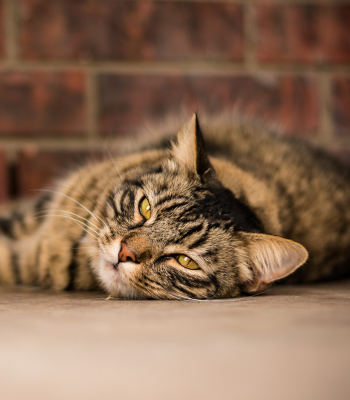Pleural Effusion in Cats: Treatment Options, Palliative Care, and How to Know When It’s Time for Euthanasia
Pleural effusion is a buildup of fluid in the space around the lungs causing compression of the lungs and difficulty breathing. The most common causes of pleural effusion are heart failure and cancer. Less common causes include infection (such as a bite wound from another cat) or trauma (such as getting hit by a car). These less common causes are very rare in indoor cats. This condition can come on suddenly and feel terrifying for both cats and their families.
Cats with pleural effusion often look like they are working harder to breathe and taking very deep breaths. As it progresses they may start to breathe more rapidly or open mouth breathe. They may hide, and they may seem tired or less interested in food. The early signs can be subtle, making pleural effusion difficult to detect in cats in the early stages.
Treatment options for Pleural Effusion in Cats
Initial emergency treatment of pleural effusion in cats is to drain the fluid around the lungs (a procedure known as thoracocentesis.) Thoracocentesis is typically done under light sedation or local anesthesia. Your cat may also be provided with oxygen to help them breathe before and during the procedure. Typically after successful thoracocentesis your cat feels immediately much better.
Following thoracocentesis testing may be performed to determine the underlying cause of pleural effusion. Without treating the underlying cause, the pleural effusion will most likely come back, often within days to weeks.
By far the most common causes of pleural effusion are heart failure and cancer. Less common causes (especially in middle aged or senior indoor cats) include: feline infectious peritonitis (FIP), trauma (such as hit by car), exposure to rat poison causing bleeding into the chest cavity, and infections (such as from an animal bite).
Your vet will likely recommend testing to determine the underlying cause. Some testing they may recommend includes: chest x-rays, echocardiogram (to evaluate the heart), abdominal ultrasound (to look for cancer), bloodwork, and testing of the fluid removed from the chest cavity.
Treatment depends on the underlying cause. Below are some treatment options for the two most common causes of pleural effusion – heart failure and cancer – as well as pros and cons of treatment. Not every cat is a great candidate for treatment and some owners elect palliative care after initial thoracocentesis, especially if their cats are elderly or unlikely to tolerate treatment.
Treatment of pleural effusion caused by heart failure
- Thoracocentesis as needed (usually not needed once the heart failure is controlled)
- Diuretics (such as furosemide)
- Other medications to treat heart failure
Pros of treating heart failure in cats: - Cats often have a good quality of life at home with treatment
- Average survival time of cats diagnosed with heart failure is 6-12 months
Cons of treating heart failure: - Must give your cat oral medications, often multiple times a day
- Frequent, often costly vet visits going forward
- May not be an option for cats with failing kidneys
Treatment of pleural effusion caused by cancer
- Depends on the underlying type of cancer
- Thoracocentesis (as needed)
- Chemotherapy (for most types)
- Steroids (prednisolone)
Pros of treating pleural effusion caused by cancer in cats: - If chemotherapy is effective, may achieve remission for a period of months, occasionally longer, allowing for a period of good quality of life
- May extend the cat’s lifespan
Cons of treating pleural effusion caused by cancer in cats: - Many types of cancer causing pleural effusion do not respond, or only partially respond to chemotherapy
- Repeated veterinary visits for chemotherapy, which can be stressful and costly
- Repeated thoracocentesis may be required if not responding to treatment or only partial response
- Unlikely to achieve a cure
Palliative Care for Cats with Pleural Effusion
Since the long term prognosis is poor for many cats diagnosed with pleural effusion, and treatment is often fairly intensive, some owners elect to forgo definitive treatment and pursue comfort care only. Palliative care also plays a role when a pet owner has tried definitive treatment and the disease is no longer responding to treatment.
Some palliative care options your veterinarian may suggest for your cat with pleural effusion include:
- Regular chest taps (thoracocentesis): This removes fluid and directly helps your cat breathe better. If your cat does not mind veterinary visits and is tolerant of procedures this may be an option. It may not be a good idea for cats who are more stressed at the vet and require heavy sedation for procedures.
- Steroids – if the underlying cause is cancer. Do NOT use steroids in cats with heart failure.
- Pain medications – Medications like gabapentin or buprenorphine may be prescribed if your vet thinks your cat may have pain associated with cancer or pleural effusion.
- Anti-anxiety medications – medications such as gabapentin not only help with pain but can help relieve your cat’s anxiety associated with the disease.
It’s worth noting that chronic thoracentesis is not without risks. Each procedure carries some danger—especially as your cat becomes more fragile—and can create fear or distress. As the condition worsens, fluid may accumulate more rapidly, leading to repeated emergencies.
The goal of palliative/comfort care is to keep your cat as comfortable and calm as possible and to recognize early signs of breathing abnormalities. When your cat can no longer be kept comfortable, or when the side effects of treatment outweigh the benefits, it may be time to consider euthanasia.
How to Know When It’s Time for Euthanasia
Pleural effusion is often a progressive and ultimately terminal condition, particularly when due to cancer or heart failure.
Because cats with pleural effusion can decline very suddenly—sometimes in the middle of the night or while you’re away—it’s helpful to create a clear plan ahead of time. This is similar to having an advance directive for a human family member. It should address important questions like:
- Would you take your cat to the hospital for fluid drainage? How many times? How frequently would be too much?
- Can you medicate your cat orally? If your cat needs medications for heart failure and you cannot give your cat a liquid or pill orally, treatment may not be an option.
- What are the objective set of criteria you will choose for when to elect euthanasia so your cat does not suffer needlessly?
- Do you want your cat to have a home euthanasia rather than passing away at the hospital?
- Is everyone in your family comfortable with this plan?
It is much easier to make these decisions when you are in a relatively calm frame of mind. When we are facing an immediate crisis of possibly losing our pets, it’s easy to make the wrong decision in a panic.
Sample Criteria for Euthanasia
Every case and every family is different, but below are some criteria you might consider to include as part of a list of objective criteria for euthanasia:
- Your cat is struggling to breathe, despite treatment
- Chest taps are needed more and more frequently
- Your cat experiences a crisis that requires hospitalization, and you don’t feel it’s in their best interest to pursue it
- Medications no longer help, or your cat cannot reliably take them
- Your cat stops eating, hides often, or appears distressed
- You begin to feel that you’re treating the disease, not caring for your cat
- Owner factors: if you are starting to get concerned that you can’t leave your cat alone for more than a few hours or something terrible might happen, or if you are worried you may have to rush your cat to the hospital for euthanasia and would prefer them to pass peacefully at home, it may be time to consider euthanasia
Conclusion
I hope this guide has helped you think through end of life decisions in cats with pleural effusion. Remember, no matter what path you choose, if you focus on prioritizing your cat’s happiness and quality of life, you will do right by them.
If you are not sure what to do and would like more guidance and support, we offer comprehensive teleconsults with compassionate veterinarians. We will review all your cat’s medical records and history, discuss all your options, and help you formulate the most compassionate and loving plan for your family.
And when the time for euthanasia does come, Paws at Peace offers in-home euthanasia in all five boroughs of NYC (Manhattan, Bronx, Brooklyn, Queens, Staten Island) to help your cat pass peacefully at home, surrounded by love and family. Home euthanasia can provide your cat a gentle and dignified transition without the stress of a veterinary visit.

